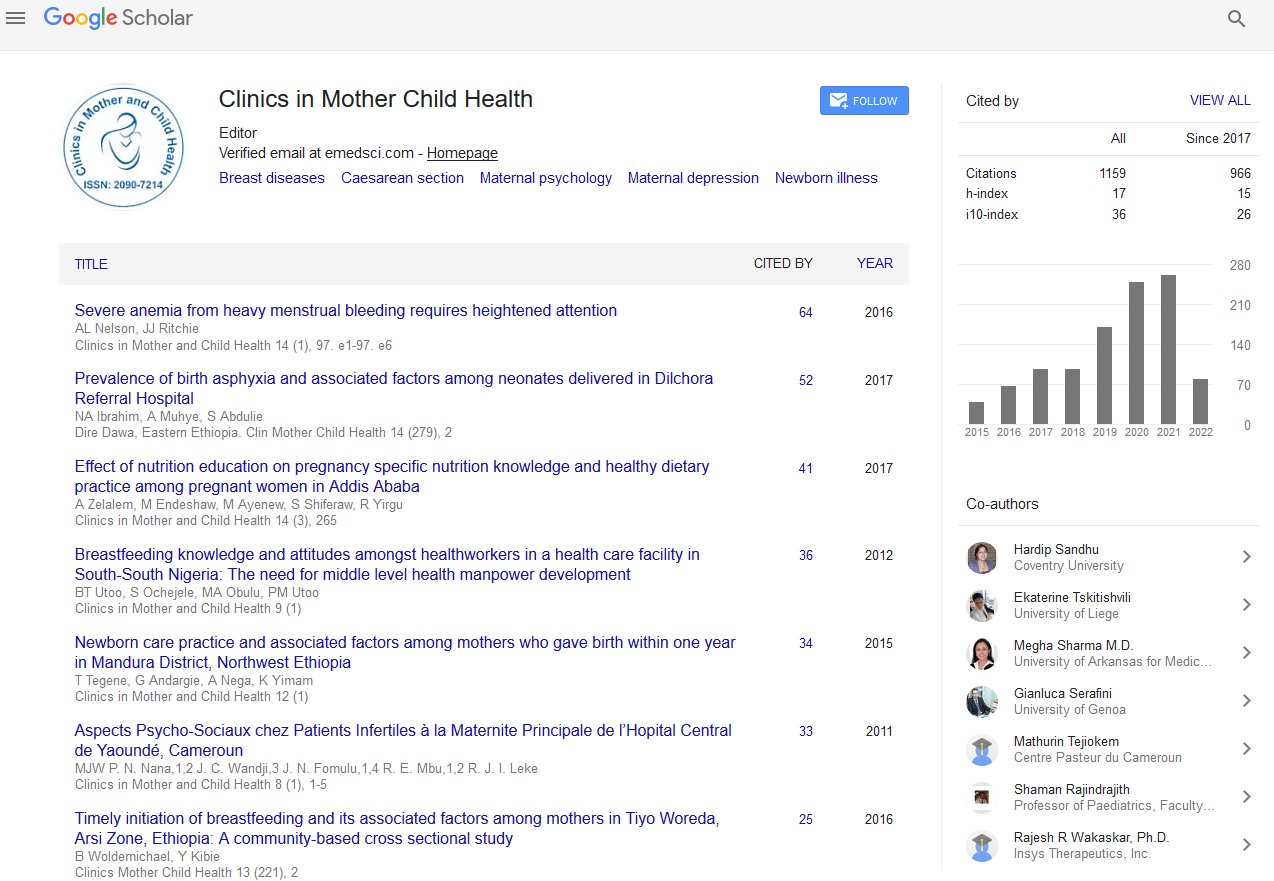Indexed In
- Genamics JournalSeek
- RefSeek
- Hamdard University
- EBSCO A-Z
- Publons
- Geneva Foundation for Medical Education and Research
- Euro Pub
- Google Scholar
Useful Links
Share This Page
Journal Flyer

Open Access Journals
- Agri and Aquaculture
- Biochemistry
- Bioinformatics & Systems Biology
- Business & Management
- Chemistry
- Clinical Sciences
- Engineering
- Food & Nutrition
- General Science
- Genetics & Molecular Biology
- Immunology & Microbiology
- Medical Sciences
- Neuroscience & Psychology
- Nursing & Health Care
- Pharmaceutical Sciences
Editorial - (2021) Volume 18, Issue 4
The Fetal Safety of Enoxaparin Use During Pregnancy
Amalia Levy*Received: 01-Apr-2021 Published: 22-Apr-2021, DOI: 10.35248/2090-7214.21.18.e353
Editors Words
Enoxaparin is widely used during pregnancy as pregnancy is a hypercoagulable state. Many studies investigated enoxaparin effectiveness during gestation however, its fetal safety has scarcely been investigated. Objective: To evaluate fetal safety following exposure to Enoxaparin during pregnancy. Enoxaparin is an anticoagulant that helps prevent the formation of blood clots. Enoxaparin is used to treat or prevent a type of blood clot called deep vein thrombosis (DVT), which can lead to blood clots in the lungs (pulmonary embolism).
Enoxaparin sodium is an anticoagulant medication. It is used to treat and prevent deep vein thrombosis and pulmonary embolism including during pregnancy and following certain types of surgery. It is also used in those with acute coronary syndrome and heart attacks. Mild irritation, pain, bruising, redness, and swelling at the injection site may occur. Fatigue or fever may also occur. If any of these effects persist or worsen, tell your doctor or pharmacist promptly. This medication can cause bleeding if its effect on your blood clotting proteins is too much.
This medication helps keep your blood flowing smoothly by lowering the activity of clotting proteins in the blood. Enoxaparin is an anticoagulant, also known as a "blood thinner." It is a type of heparin. This medicine is used for several days after hip or knee replacement surgery, and in some cases following abdominal surgery, while you are unable to walk. It is during this time that blood clots are most likely to form. Enoxaparin is also used if you are unable to get out of bed because of a serious illness. Enoxaparin has been increasingly used over the past 20 years in pregnant women at risk of thrombosis and pregnancy complications. The main indications are prophylaxis of venous thromboembolism and prevention of pregnancy loss in thrombophilic women.
Exposure to enoxaparin during the first trimester of pregnancy was not associated with an increased risk of major congenital malformations [adjusted odds ratio (aOR) 1.1, 95% confidence interval (CI) 0.8-1.6], while exposure during the third trimester was not associated with an increased risk of low birth weight. Use of low dose of aspirin and low molecular weight heparin (Enoxaparin) is safe in pregnancy and it improves foetal outcome.
Bleeding is a potential complication of anticoagulant therapy, heparin induced thrombocytopenia has been observed less commonly in patients treated with LMWH. Low-molecularweight heparin is the anticoagulant of choice in pregnancy. Enoxaparin has been increasingly used over the past 20 years in pregnant women at risk of thrombosis and pregnancy complications.
Enoxaparin does not cross the placenta and is safe for the fetus. Conclusions The use of enoxaparin in pregnancy is associated with a low incidence of complications and a dose of 40 mg once daily throughout pregnancy provides satisfactory anti-factor Xa levels and appears effective in preventing venous thromboembolism. The more common side effects of enoxaparin can include: bleeding. anemia (not having enough healthy red blood cells) pain and bruising at the site on your skin where you give the injection
Citation: Levy A (2021) The Fetal Safety of Enoxaparin Use During Pregnancy. Clinics Mother Child Health. 18:e353.
Copyright: © 2021 Levy A. This is an open-access article distributed under the terms of the Creative Commons Attribution License, which permits unrestricted use, distribution, and reproduction in any medium, provided the original author and source are credited.


